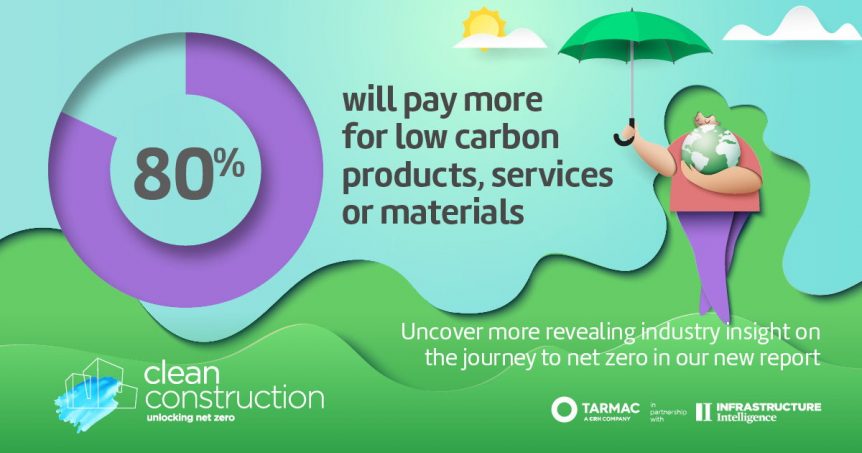By Nick Toy, senior national commercial development manager, Tarmac
Delivering net-zero undoubtedly requires a significant cultural and behavioral shift for everyone involved in construction and infrastructure. What training and education is required to make the transition and unlock the opportunity? How important is client leadership to help the supply chain deliver better social and environmental outcomes?
These were just some of the issues that we wanted to explore as part of our research – Clean construction: unlocking net zero. The results provide an interesting assessment about current levels of awareness, training and the role of the client to set up projects for net-zero success.
Here are five learnings from the research:
- People want training for a net-zero world and some would like this before COP26
COP26 is seen as a significant threshold for many people. Before the summit doors open in Glasgow in November, nearly half of respondents to our research want more guidance and training to help the infrastructure sector decarbonise.This for me is actually very positive news because it shows a willingness to want to learn. It’s a firm acceptance that collectively we don’t yet have all the answers. It means that when people are empowered with knowledge and training, they will think carefully about what they do and the environmental choices they make. It’s important to recognise that progress is being made with the Construction Leadership Council’s skills plan and the Supply Chain Sustainability School.
- Client leadership can create a culture of ‘how can we do even better?’
It’s clear from our research that if and how a project measures carbon and at what stages across its lifecycle is often shaped by clients. For many contractors, carbon evaluation is an opportunity cost – if the client is willing to pay, of course it will happen.There are currently occasions when clients are picking carbon targets that are at the lowest common denominator. This is to keep a level playing field within the supply chain but it’s not always stretching anyone to innovate or helping to develop approaches that will lead to improved environmental outcomes.
The race to net-zero will require clients and everyone in the supply chain to go ‘above and beyond’ as a standard. That’s a significant cultural and behavioral shift for a construction industry that sometimes has accepted average performance; often because the data hasn’t been assembled to prove it. The aim should be to set challenging but deliverable baselines and measure performance over a sustained period that considers the whole life performance of assets.
- Net-zero is seen as a priority and business opportunity
Well over a third of respondents said that net-zero provided a significant advantage for their business. This level of response again felt in line with the way many businesses are talking about the climate emergency and shaping their commercial propositions.But do people really understand the major transformation that will be required and are they prepared to pay more for products and materials that will deliver improved environmental outcomes?Well, nearly 80% of respondents initially expressed some level of willingness to pay more for low carbon products, services or materials. 10% said that they would pay significantly more, 31% would be happy with a moderate increase and 39% indicated that they would do this if it was a slight increase.
Government as one of the largest construction clients has a role to lead by example here, in committing to products and materials that will deliver carbon savings while using the public purse wisely. This is also about procurement teams thinking about and considering the whole life carbon and cost impacts of product selection.
- There is a myriad of approaches to cutting carbon – early supply chain engagement is key
There are undoubtedly major contractors taking some great steps to forensically understand how to reduce carbon across the lifecycle of a project. They have created bespoke tools to understand baseline data and then they use this to understand the opportunities and constraints for live projects. This is excellent and it’s great to see they are being collaborative with suppliers.There does, however, need to be a standard approach and common tools across the industry, as too many are attempting to build their own carbon databases. Sometimes this does not help anyone to have more informed discussions about the whole-life performance of a product or the lifecycle impact of a project. High quality, best practice tools are already out there; the only way we can ensure clarity is to align them all to the PAS 2050 standard.
This needs to become a standard approach to deliver greater savings. Engaging with construction products manufacturers in the preliminary design process will help clients and contractors make better-informed decisions about materials and design specifications that improve whole-life performance.
- Let’s turn the confidence into net-zero delivery
Whether it’s because many construction businesses have adapted well to the challenges of the pandemic or that companies have pivoted and put net zero high in their commercial strategies, there is an air of confidence about the UK’s ability to become net zero. Over 60% of respondents are slightly or moderately confident that the UK can deliver the Prime Minister’s target to reduce carbon by 68%* by 2030.Yes, many people want more clarity from the government on a net-zero roadmap, but there is undoubtedly great scope to harness the optimism and the steps already taken to put this into delivery in 2021.
To read the full Clean construction: unlocking net-zero report, produced by Tarmac in partnership with Infrastructure Intelligence, click here: https://www.tarmac.com/clean-construction-report/

